Developments in LEDs
by Matthew | 19 February 2012 2:43 pm
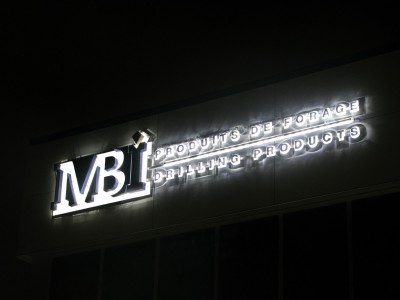 [1]
[1]Photos courtesy Permlight
By George Preston
Light-emitting diodes (LEDs) have been around for more than 40 years, but only recent innovations and technological advances have made them bright enough to become useful for commercial settings. With their semiconductor chips made from ultra-high-purity materials under tightly controlled conditions, today’s LEDs can sustain high light output in demanding operating environments.
LED-based luminaires are generally more expensive than traditional illumination sources, but use as little as one-fifth as much energy to produce equivalent light output, which can mean a very short payback period by reducing energy consumption costs. Further savings are gained because of LEDs’ long lifetimes.
While LEDs are now well-known throughout the sign industry, the market is not yet mature and continues to provide new and interesting applications for them. LEDs aimed at this market were initially installed in channel letters, for instance, but there are still many opportunities to bring them into sign cabinets, which mostly use fluorescent lighting. There are also opportunities to light larger-format sign letters, i.e. 0.6 to 0.9 m (2 to 3 ft) tall and up.
The evolution of LEDs has essentially unfolded the way many people in the industry predicted it would. There was an early need to increase the brightness of LED packages to support applications like deep sign cabinets—and that has indeed happened, steadily.
The illumination efficiency of LEDs has been improved as manufacturers process new chips and wafers. The gains in efficiency have yielded much brighter products—and for better value, as high-brightness (HB) LEDs used to be very expensive.
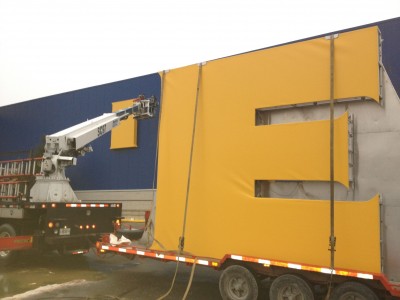 [2]
[2]LEDs are just beginning to be used to illuminate larger sign letters.
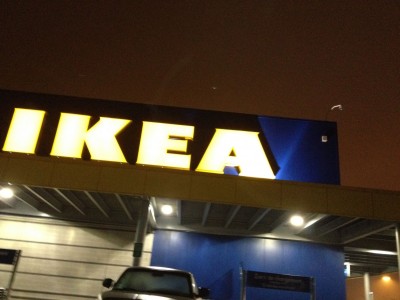 [3]That said, a lot more can yet be gained in terms of value, brightness and efficiency. Today’s best chips only produce about 30 per cent of their theoretically expected efficiency, due to tiny defects in the chips and the optics of the packaging surrounding them. Many industry experts are confident this value can be increased to 60 per cent or more in the years ahead.
[3]That said, a lot more can yet be gained in terms of value, brightness and efficiency. Today’s best chips only produce about 30 per cent of their theoretically expected efficiency, due to tiny defects in the chips and the optics of the packaging surrounding them. Many industry experts are confident this value can be increased to 60 per cent or more in the years ahead.
Some very large applications continue to evade LEDs. Many roadway signs, for example, use a high-intensity discharge (HID) metal halide light, while high-pressure sodium produces a very bright yellow glow for some other large signs. These applications represent a major challenge for even the brightest LEDs, if configured in their traditional manner.
Optimizing optics
Along with gains in brightness, a concurrent development in the LED industry has been a new focus on the area of optics, to ensure even luminance across sign letters’ faces, preventing bright or dark ‘measles’ from showing up.
All different light sources have their own characteristics to work around. LEDs offer energy efficiency and long useful life, but they are directional sources, emitting a specific beam of light rather than creating ambient illumination.
As LED manufacturers’ research and development (R&D) efforts have led to better-designed LED packages, they have integrated optics—including secondary and supplemental lenses—around the LEDs. These are able to achieve broader light beam distribution.
Such optics are also helpful in creating even luminance with shallow channel letters, which are not a big trend in Canada, but have become popular in markets like the southeastern U.S. Edge-mounted lighting of shallow sign cabinets, however, is becoming mainstream on a widespread basis. Tim Hortons, for example, recently announced a rollout of outdoor menu boards that are illuminated this way because of the efficiencies in cost and size. LEDs are so small, they can fit almost anywhere.
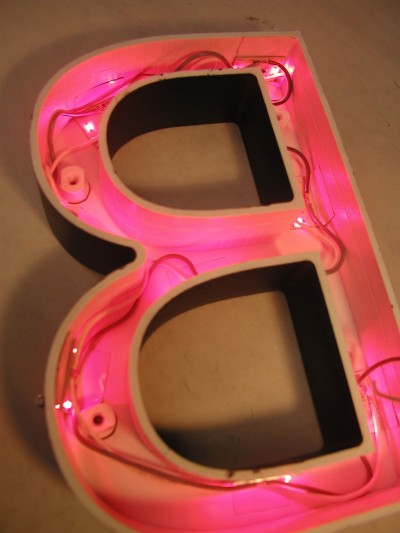 [4]
[4]
 [5]
[5]With well-designed optics, signmakers can install fewer LEDs in channel letters and still achieve the desired level of lumen output.
On the other hand, well-designed optics mean signmakers can install fewer LEDs and still achieved the desired level of lumen output. Durable chips’ costs may be higher, but by installing fewer strokes of LEDs through a sign letter or cabinet, reducing the number of LED modules and drivers per foot, the overall cost of lighting a sign can become much lower.
This trend has changed the way the economics of LEDs are calculated.
Hot or cold
Another factor, of course, is durability itself. When operated properly, LEDs do not burn out like normal light bulbs, but instead dim over time. The most common industry standard measure for rating their useful lifetime is the point at which the light output is 70 per cent of its initial lumen value.
Under proper conditions, most LEDs’ lifetime can exceed 40,000 hours, which is greater than 4.5 years of continuous operation. Compared to other lighting, this can mean substantial savings in maintenance. Many large programs of LED-based signs are driven a desire to reduce the costs of sign maintenance, with a less frequent need to call for a high lift or cherry picker.
LEDs also do very well in low outdoor temperatures compared to neon and other light sources. In fact, the cold helps them maintain their long performance life.
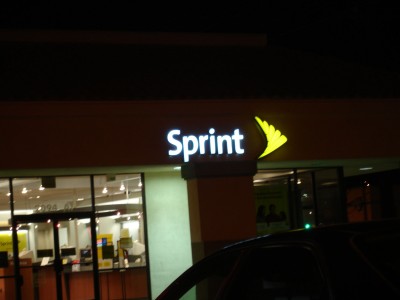 [6]
[6]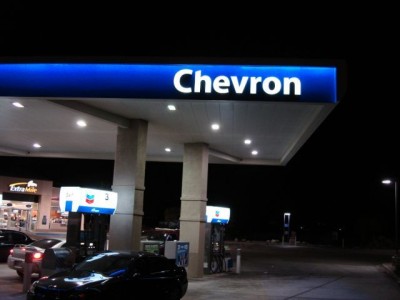 [7] Today’s LEDs can sustain high light output in demanding operating conditions. They do particularly well in low outdoor temperatures, as the cold helps them maintain long performance life.
[7] Today’s LEDs can sustain high light output in demanding operating conditions. They do particularly well in low outdoor temperatures, as the cold helps them maintain long performance life.
Excessive heat, on the other hand, can cause problems. When LEDs were first installed in signs, there was a steep learning curve, with many failures due to overheating.
Since LEDs produce no infrared (IR) or ultraviolet (UV) light, they are generally cool to the touch and radiate less heat than traditional light sources. The heat they do produce, however, is still an issue, as it must be conducted away from the back of the semiconductor chip. Indeed, thermal management has turned out to be one of the most important factors in determining the performance and life of an LED.
Early LEDs for signs were not always mounted on a heat-sink backing. (Unlike other light sources, which emit heat and light in the same direction, an LED emits light to the front and conducts heat out the back.) As a result, LED suppliers and system designers worked with sign fabricators to produce heat-conductive metal backings, preferably using aluminum. These continue to be used for high-power LEDs today.
For another thing, LEDs have become much more efficient. So, where early products failed, many of today’s LEDs do not necessarily need a heat sink, unless they are high-power models. Many chip sets that have proven successful even in the sign industry can be mounted on almost any type of material without worry of failure.
To keep on the safe side, some categories of LEDs are now provided to the sign industry mounted on metal-core boards. This is like starting with a built-in heat sink.
As LEDs have become less heat-sensitive, the emphasis of engineering has switched to focus on drivers and power supplies. These systems almost always have heat-sensitive electrolytic capacitors that can fail. As such, they have become the new weak point in a sign system.
With the undesirable consequence of LED drivers becoming the components that determine how long an LED will last, the industry’s focus will need to expand to improve their performance. On the testing and measurement side, for example, there is currently a lot of effort being put into standardization, to make LED manufacturers’ claims of longevity more believable.
Also, as the installed base of LED systems increases, more emphasis is being put on their power-factor characteristics and low total harmonic distortion (THD).
Motivating factors
Standardization may not be appropriate for LEDs themselves, however, outside of general illumination applications. This is because, for the most part, every sign is different and unusual. There is still a great degree of artistry and craftsmanship in the industry, rather than a one-size-fits-all approach.
Also, additional efforts to cut energy consumption are still not as major a decision factor in the sign industry as they are elsewhere. Instead, the adoption of LEDs has been motivated by efforts to reduce costs, e.g. by using fewer drivers and needing less frequent maintenance. Improved efficiency is a secondary ramification compared to cost-effectiveness.
George Preston is CEO of Permlight, which designs and manufactures light engines for LED systems for signage and other markets. For more information, visit www.permlightforsigns.com[8].
- [Image]: http://www.signmedia.ca/wp-content/uploads/2014/02/IMG_5324.jpg
- [Image]: http://www.signmedia.ca/wp-content/uploads/2014/02/iphone-pics-1-007.jpg
- [Image]: http://www.signmedia.ca/wp-content/uploads/2014/02/iphone-pics-1-025.jpg
- [Image]: http://www.signmedia.ca/wp-content/uploads/2014/02/P6200021.jpg
- [Image]: http://www.signmedia.ca/wp-content/uploads/2014/02/iphone-pics-1-011-2.jpg
- [Image]: http://www.signmedia.ca/wp-content/uploads/2014/02/DSC00215.jpg
- [Image]: http://www.signmedia.ca/wp-content/uploads/2014/02/Chevronband.jpg
- www.permlightforsigns.com: http://www.permlightforsigns.com
Source URL: https://www.signmedia.ca/developments-in-leds/